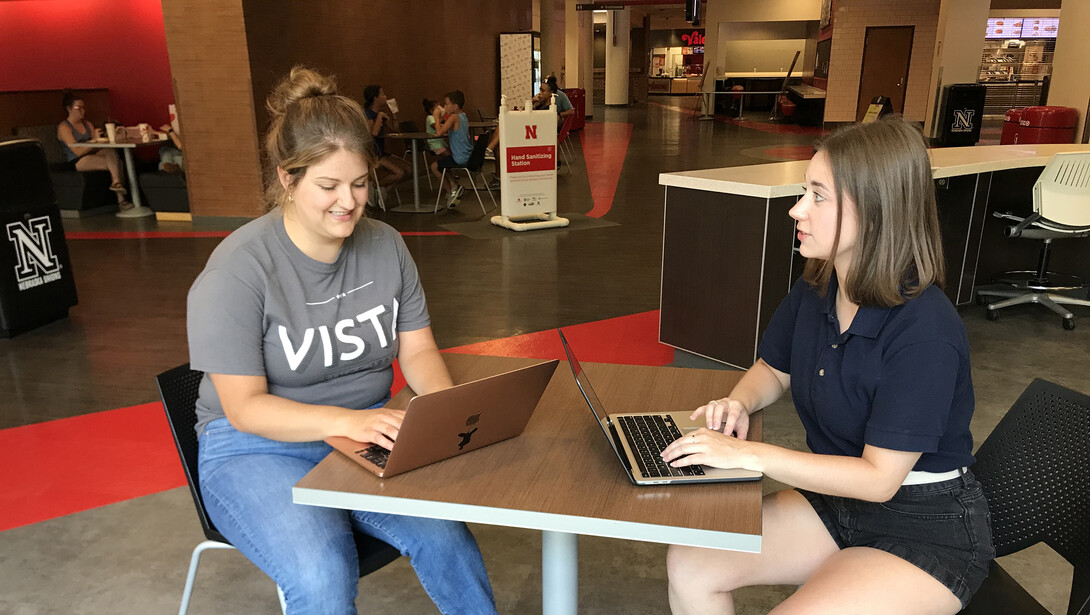
There are new faces joining the ranks of Nebraska Extension, and they have a very specific goal — to increase the capacity and access of Extension programming, specifically in disaster resilience and combatting poverty.
In 2021, Nebraska Extension earned grant funding from the AmeriCorps VISTA program, allowing for the hiring and training of AmeriCorps VISTA members to work on community-focused projects encompassing food access, climate resilient agriculture education and disaster preparedness and response.
AmeriCorps VISTA is a national service program designed to alleviate poverty. President John F. Kennedy originated the idea for VISTA, which was founded as Volunteers in Service to America in 1965. The program was incorporated into the AmeriCorps network in 1993. While AmeriCorps is known for community service, VISTAS are charged with increasing program capacity, often in administrative or community outreach roles.
Julien Hoffman, AmeriCorps VISTA program coordinator with Nebraska Extension, said VISTAS at Nebraska have a variety of responsibilities, from designing graphics and mailers and updating social media accounts to answering community questions and writing grants. Each VISTA position is unique, but they all share the common goal helping at-risk Nebraskans through expanding programming capabilities and reach.
“When we choose placements for VISTAs, we look at how the program could be expanded and how that could positively impact the public,” Hoffman said. “Our VISTA program is designed to focus on helping people who have been through a disaster, and there are many types of disasters, including natural and economic disasters, which can really impact people who have a lower income and are already at risk. And if you think about it, our state has been through some major disasters, with the flooding of 2019 and then the pandemic.”
Nebraska’s VISTA program is also unique in that few universities have applied for the program, Hoffman said. The grant can fund up to 13 VISTA members, and Hoffman is recruiting for eight positions, which are available throughout the state. Applicants must have a bachelor’s degree, and be able to commit to a full year of service. There are currently two on board, one in Lincoln and one in Omaha. Hoffman said AmeriCorps is often thought of as an opportunity for younger people, but VISTAs can be any age.
“It is great for students who want to take a gap year before graduate school, but we’ve also worked with retirees who want to do it as a way to stay involved in their community and do something really fulfilling,” Hoffman said. “It could also be an opportunity for someone who wants to try something new, to serve their community and gain new skill sets.”
Sydney Sehi, a VISTA with the Douglas-Sarpy County Extension office, said she applied for the program to begin working again after a series of health-related setbacks. She is working on food access and urban agriculture projects. Being a VISTA allowed her to serve her community and work on projects she was already passionate about — community gardening and neighborhood food cooperatives — and stretch the skills she learned getting her bachelor’s at Nebraska in anthropology and studio art.
“The stars aligned, and it’s been great to get to use those skills again,” Sehi said. “I’ve been interested in food security, and was something I’d been working on personally, in my neighborhood, for a year.”
Now, Sehi is working on projects meant to bring more people to the table — developing and sharing information on local food security programs, including community gardens, food banks and farmers markets, to benefit both consumers and producers. She’s also building out platforms for future communication with the community, and helping some grow their own food.
“One of the big line items on anyone’s budget is being able to feed themselves,” Sehi said. “It affects every aspect of their lives.”
Extension’s VISTA program is already making an impact. Candace Hulbert, who has served as the Weather Ready Farms VISTA for the past year, helped grow Weather Ready Farms from a new idea into a pilot project with nine producers working toward making their operations more resilient.
“[This experience] taught me the value of serving the community and self-sacrifice,” Hulbert said. “When I started my service year, Weather Ready Farms was mostly just an idea, and I spent my service year laying the groundwork for what a statewide resilient agriculture system would look like. I have spent my service building the Weather Ready Farms capacity, expanding the project team, grant writing to collect program funding, and creating tracking systems.”
For Hulbert, completing a VISTA service year solidified a career path she’d long been interested in pursuing.
“My service inspired my decision to go to Cornell University to their College of Agriculture and Life Sciences to get a master’s of professional studies in the field of natural resources,” she said. “This degree is capstone focused and my project will center around Weather Ready Farms. I plan to spend my life combating the climate crisis and helping farmers and ranchers prepare and recover from disasters.”







